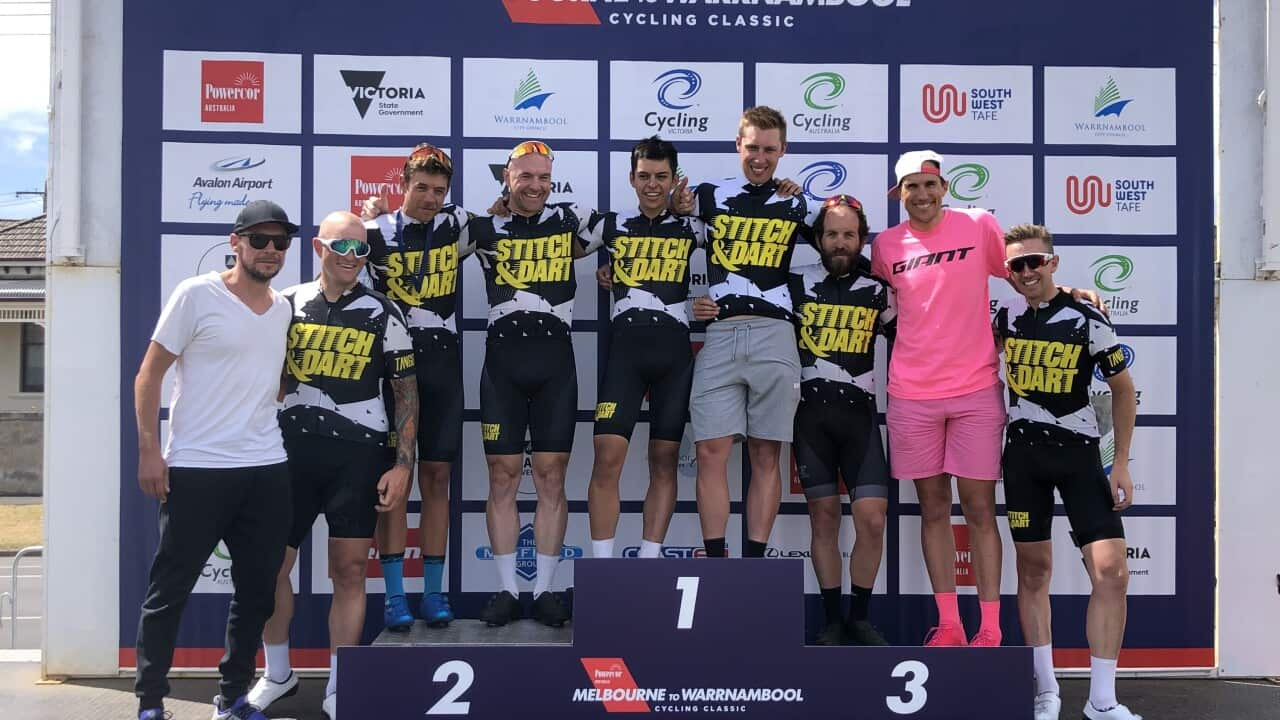Lots of little stories unfold in each edition of Australia’s oldest one-day classic, the Melbourne to Warrnambool (M2W).
Tales of personal triumphs after months of hard training, rides in memory of family, plus stories of heartache and disappointment from crashes, punctures and mechanicals, unplanned DNFs, or rides that simply didn’t go to plan.
The main story of the 103rd edition was Nick White's victory after spending most of the day in the break. It was a great result for the 21-year-old current under 23 National Road Champion from Ballarat riding for Team BridgeLane.
But a story with possibly wider ramifications also unfolded on those same roads between Avalon and Warrnambool. A Melbourne-based amateur wildcard team, Stitch & Dart, took it up to the sponsored NRS pro teams by grabbing third place with Brendan Johnston, first Warrnambool rider home (Ryan Brodie), and the teams classification.
Who is Stitch & Dart? How does a team working full-time jobs do so well in a race like M2W against funded teams?
What does it mean for the current state of domestic racing in Australia, the NRS system, and how our one-day classics are being raced today?
I caught up over coffee recently with well-known Stitch & Dart rider Tommy Nankervis to put those and other questions to him.
The Stitch & Dart concept
In 2016, a group of friends from the Carnegie Caulfield and St Kilda cycling clubs decided one day it’d be fun to ride the big Melbourne bunch rides together with matching kit and bikes. Former track star Todd Wilksch was the main driver behind the idea. Through their connections to Giant Australia and the designer behind the group formed initially as Team Detours, and then Stitch & Dart (S&D)– ‘Stitch em up and dart to the line’ is one of their mottos.
“In essence, we’re a Giant Ormond sponsored team, fully supported by Giant Australia” says Nankervis. “We’re really grateful to have that support.”
Out of convenience due to other commitments, the core S&D group focus mainly on local criterium and road races around Melbourne, but entered the odd endurance MTB event for a laugh. They’re also passionate about the Warrnambool Classic, especially Nankervis.
“The history of cycling is really important to me," Nankervis said. "Having grown up in a cycling family hearing all the stories and going to the races as a kid”.
"The Warrnambool is one of the most iconic and long standing races in the country, so it has always been special to me.”
Tommy’s first Warrnambool was in 2003 where he struggled home for 43rd – a solid result considering the fields back then (Simon Gerrans won that race in a year also with international riders in the mix). Nankervis was hooked. So he took on 1987 Warrnambool winner Paul Rugari as a coach for the 2005 edition and finished sixth. He has raced nine Warrnambools, finishing top 10 four times (including third in 2017).
Nankervis is certainly an accomplished rider. in the US and Europe, won the 2009 Oceania Road Race, and raced for two seasons in the NRS with Budget Forklifts. His local A grade crit performances are remarkable too, winning 68 races between 2014 and 2018 and finishing no worse than third in 2019 so far.
But despite those numbers, you get the sense from Nankervis, the S&D thing is not about results.
“We’re more just a group of mates having fun than a cycling team, really, he said. “You’ve got some older dudes who seem younger and some younger dudes who play their role, and we all motivate each other.”
Clear proof of that is Ryan Brodie. The 33-year-old is a milk tanker driver who was a S&D guest member and first Warrnambool rider home this year. His friendship of more than 20 years with Nankervis helped Brodie get fit again for 2019 after more than a decade away from racing. Remarkably, when Brodie drove the support car for Nankervis in the 2017 Warrnambool, he weighed in at 164kg.
“He busted his arse, and trained the house down and now is half that,” Nankervis said beaming. “Being a part of that, and being a part of his journey for the last year and a half has just been unreal…we talk every day.”
Amateur riders punching above their weight?
Theoretically, an amateur team like S&D with an average age somewhere in the 30s, and working full-time jobs, shouldn’t be able to do well in a race like the Warrnambool. It is supposed to be Australia’s toughest one-day race, and the official view is the sponsored NRS teams contain Australia’s best road cyclists.
But the seven riders who rode the M2W are no slouches. Alongside Nankervis, there are other decent athletes in the mix – Brendan Johnston is a three-time national cross country marathon champion, Daniel Furmston finished second in the 2009 Warrnambool, Jake Klajnblat is a past Tour of the South Coast stage winner, and the others are solid A grade riders (Adam McGillivray, Luke Jones).
Also in their team car this year was Lee Turner (past President of St Kilda Cycling Club and three-time Warrnambool finisher), and Jeremy Hunt – ex-Euro pro, Team Sky rider and two-time British road champion (1997 and 2001).
But even acknowledging the capacities and race smarts in the S&D group, getting two riders in the break, standing on the Warrnambool podium, and taking out the team classification against the current cream of Australia’s domestic road cycling talent is a significant result worth examining.
Nankervis puts the team’s results this year down to how the NRS teams race the world’s second oldest one-day classic. And he doesn't like it one bit.
Implications for domestic bike racing in Australia?
Nankervis believes the NRS teams' tactics have taken over the Warrnambool, changing the classic for the worse.
“It seems to me that each team sends seven dudes, and then they all just get one up the road, whether that guy is likely to win or not, they’re just happy for that,” he said.
“Maybe teams should just nominate one rider each, and just let them race…save all the traffic controllers…you could probably do it on Zwift nowadays” he added, laughing.
Nankervis might be smiling, but he is genuinely concerned. “The NRS teams style of racing is butchering what was otherwise a classic race. If you’re going to lose 15 minutes and then just roll along for the next five hours at 100 heart-rate, it's not really racing, is it? You get 200 people who train their arse off to do the race, and then all they want to do is to just roll along at 100 heart-rate...it’s idiotic.”
“The Warrnambool is not an epic hard man’s race anymore, where people come home in tatters. It’s a chess game.” Nankervis added.
Nankervis is especially unhappy about the negative tactics he sees in the Melbourne to Warrnambool these days, like riders with teammates in the break blocking up front, or deliberately drifting off wheels to open tactical gaps and slow the main bunch.
“When that's the way they’re trying to create bunches on the road, by slowing instead of going faster, then the whole sport is backwards. Splits are meant to come from difficult racing not from tactical negative racing,” he explained.
Nankervis believes the genesis of this style of racing is the increasing emphasis on team-based GC stage races in Australia. That racing style with its focus on just a handful of riders with any chance of winning has no place in a one-day classic like the Warrnambool and has wider implications, he believes.
“I mean, where does Cycling Australia want the sport to be? Where do they want racing to lead? We’re not creating a culture of being first to the finish line, because everything is GC racing and people focus on their time trial or teammates…but then what? There’s no learning on how to cross the line first.”

Brendan Johnston (R) finished third for the plucky amateur team Stitch & Dart at the Melbourne to Warrnambool (Con Chronis) Source: Con Chronis
The future
There’s a lot to like about the S&D story. It harks back to ‘the Warrnambool’ glory days where scores of hopeful amateur club racers would enter for a shot at possible glory against the elite scratch-men.
Naturally, those plucky hopefuls rarely got up against the best riders in the country. But when they did, their stories helped to build widespread public fascination and passion for this great one-day classic and also inspired future riders to want to be part of it.
The Australian road-racing scene is different now, and it is clear the romance and sentimental appeal of the old days won’t be enough to sustain the future. Fortunately, the Warrnambool Citizen’s Road Race Committee, Cycling Victoria, and the team responsible for delivering the new course and approach to the Warrny made some positive changes and look committed to preserving what is arguably Australia’s greatest ever one-day classic.
But, if you believe Tommy Nankervis, even bigger changes at the national level will be needed to address the way the Warrnambool Classic race is currently raced.
“I genuinely don't see the sport moving forward,” he says. “I don't see the culture moving forward. I don't see our race winning ability improving. There’s a lot of good riders out there but they don't come to races. Or if they do they don't know how to win.”
“If I were a young guy I would be trying to be on one of these amateur teams like Stitch & Dart,” said Nankervis. “Firstly, you’d bring a lot of enthusiasm to the older dudes, and motivation to ride. Secondly, you’d learn heaps. If a young guy came to a team like ours they’d probably be the team leader, and you can race to win.”
While we might applaud an underdog amateur team doing so well against Australia’s best domestic NRS riders, such a result raises important questions for the Warrnambool and the Australian domestic racing scene generally.
At the heart of the matter is how NRS team tactics are impacting the Melbourne to Warrnambool Classic in a period where Australia’s oldest bike race was struggling for a long time to survive, and how bodies like Cycling Australia, Cycling Victoria, and the Warrnambool Citizen’s Road Race Committee should respond.
Inaction may undermine current attempts to return the Warrny to its rightful place as Australia’s toughest and most popular one-day classic.
In the meantime, whatever happens next, S&D will keep on rolling. Ultimately, they’re simply a group of mates who love riding their bikes together, being fit and finding some form every now and then.
“We’re just a bunch of flogs who enjoy racing and riding our bikes for fun,” Nankervis says with a big grin. “We’ll be back next year for sure.”
Craig Fry is a freelance cycling writer based in Melbourne. @pushbikewriter on and .



